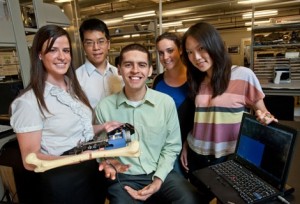 Students Develop Bone-Lengthening Device (Biloine Young @ OTW)
Students Develop Bone-Lengthening Device (Biloine Young @ OTW)
Life is about to get a whole lot better for children undergoing distraction osteogenesis, thanks to a group of senior students at Rice University, Houston, Texas. Distraction osteogenesis is a method of correcting bone deformities that leave one limb shorter than the other. About 10 million children have this problem in either their arms or legs.
To correct it, surgeons break the bone and insert a distractor that stretches the bone and, over time, tugs it to the appropriate length. To keep constant tension on the bone, the patient has to, four times a day, give a screw in the bulky device a quarter turn.
Current patients wear distractors for as long as it takes to complete the process of lengthening the bone, typically two to four months. Then they leave the device on for six more weeks, while the bone sets. Mechanical engineering student Raquel Kahn, a member of the student team, said that each of the Rice students working on the project wore a standard distractor (minus the bone-drilling part) for 24 hours to get a feel for what patients endure.
At the urging of Gloria Gogola, M.D., a hand and upper extremity surgeon who specializes in pediatrics, the students developed a motorized, automated linear distractor, called the LinDi, which does away with the manual manipulation of the screw. It also protects the fragile soft tissues and nerves from being overstressed.
“The process of limb lengthening—essentially creating a localized mini-growth spurt—works well for bones, but is very hard on the soft tissues such as nerves and blood vessels,” Gogola said in the April 23 news release. “This team has done an outstanding job of designing a creative solution. Their device not only protects the soft tissues, it will ultimately speed up the entire process.”
Kahn said, “The problem with the current device is that there’s a lot of room for error. You can imagine that one might forget to turn it once, or turn it the wrong way, or turn it too much. And a lot of problems can arise in the soft tissue and the nerves surrounding the bone. That’s the limiting factor of this process. But LinDi implements a motor to make the distraction process nearly continuous.” She said that the motorized, battery-operated LinDi adjusts the device almost 1,000 times every day, “so the process is more gradual and continuous, similar to actual bone growth.”
This group of students will soon be graduating. However, another team will take up the LinDi project, do additional testing and attempt to make the device less bulky.
